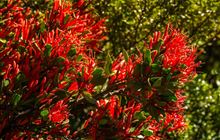Maruia mistletoe making a comeback
Introduction
Look out for the bright red and yellow blooms of mistletoe if you’re travelling through the Lewis Pass this summer or exploring tracks in the area.Date: 15 December 2023
Sustained possum control in the Maruia River valley east of Reefton is helping native mistletoe populations revive.
Mistletoe are semiparasitic plants found in the forest canopy that rely on a host tree or shrub for water and nutrients. Three of the nine native species – red, yellow and scarlet mistletoe – are present in the Maruia beech forest.
Department of Conservation Senior Ranger Biodiversity Darrell Haworth says unfortunately for mistletoe possums find them delicious, and they have disappeared from forests where there is no pest control.
“The monitoring we’ve been doing since 2006 indicates predator control work in the Maruia has successfully reduced the impact of possums on local mistletoe populations. Red and yellow populations show signs of recovery, and the scarlet population has improved.
“It’s good news but we can’t relax our efforts. Mistletoe is like ice cream to possums and population recovery is slow. This recovery will be hampered or even reversed if possum populations increase so we really need to keep on top of them. We’re planning to extend control work to lower their numbers in the wider area in and around Lake Daniells and Alfred River.”
Native mistletoe populations have declined across New Zealand and scarlet and red mistletoe have a conservation threat listing of ‘At Risk – Declining’ and ‘Conservation Dependent’, respectively.
Darrell Haworth says it’s not just mistletoe that possums threaten in the valley.
“Kākā eat nectar, as well as fruit, seeds and insects. They’re known to congregate when mistletoe flower and nest in the Maruia. Possums wreak havoc in their nests eating the eggs and chicks.”
The Maruia valley has played an important part in New Zealand’s conservation history, being the inspiration for the Maruia Declaration, which called for legal recognition of native forests and an end to their logging.
Today the Maruia is a priority area for DOC’s national predator control programme. As well as predator control using aerially applied 1080, there’s a trapping programme supported by mining company, Oceana Gold.
Contact
For media enquiries contact:
Email: media@doc.govt.nz

